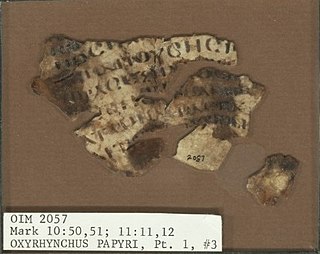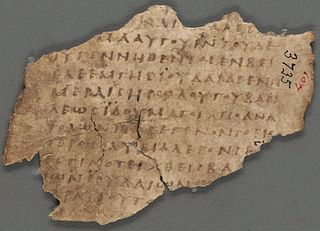| New Testament manuscript | |
| Text | Matthew 11:20-21 |
|---|---|
| Date | 7th century |
| Script | Greek-Coptic |
| Now at | British Library |
| Size | 16.5 cm by 7 cm |
| Type | mixed |
| Category | III |
Uncial 0200 (in the Gregory-Aland numbering), is a Greek-Coptic diglot uncial manuscript of the New Testament, on parchment. Palaeographically it has been assigned to the 7th century. The manuscript has survived in a very fragmentary condition. [1]
The codex contains a small parts of the Gospel of Matthew 11:20-21, on one parchment leaf (16.5 cm by 7 cm). The text is written in two columns per page, 17 lines per page, in very large uncial letters. [1]
The Greek text of this codex is mixed. Aland placed it in Category III. [1]
Currently it is dated by the INTF to the 7th century. [1] [2]
It was examined and described by H. J. M. Milne. [3]
The codex currently is housed at the British Library (Pap. 2077 C) in London. [1]

There have been many Coptic versions of the Bible, including some of the earliest translations into any language. Several different versions were made in the ancient world, with different editions of the Old and New Testament in five of the dialects of Coptic: Bohairic (northern), Fayyumic, Sahidic (southern), Akhmimic and Mesokemic (middle). Biblical books were translated from the Alexandrian Greek version.

A biblical manuscript is any handwritten copy of a portion of the text of the Bible. Biblical manuscripts vary in size from tiny scrolls containing individual verses of the Jewish scriptures to huge polyglot codices containing both the Hebrew Bible (Tanakh) and the New Testament, as well as extracanonical works.

Uncial 069, ε 12 (Soden), is a Greek uncial manuscript of the New Testament, dated paleographically to the 5th century.

Uncial 071, ε 015 (Soden), is a Greek uncial manuscript of the New Testament, dated paleographically to the 5th or 6th century. It came from Oxyrhynchus.
Uncial 0100, ε 070 (Soden), is a Greek-Coptic diglot uncial manuscript of the New Testament. It is dated palaeographically to the 7th-century.
Uncial 0163, is a Greek uncial manuscript of the New Testament, dated palaeographically to the 5th century.

Uncial 0169, known also as the Princeton fragment, is a Greek uncial manuscript of the New Testament, dated palaeographically to the 4th century.

Uncial 0177, is a Greek-Coptic uncial manuscript of the New Testament, dated paleographically to the 10th-century.

Uncial 0183, is a Greek uncial manuscript of the New Testament, dated palaeographically to the 7th century.

Uncial 0184, is a Greek-Coptic diglot uncial manuscript of the New Testament, dated paleographically to the 6th century.
Uncial 0198, is a Greek uncial manuscript of the New Testament, dated paleographically to the 6th century.
Uncial 0204, is a Greek-Coptic diglot uncial manuscript of the New Testament, dated paleographically to the 7th century.
Uncial 0219, is a Greek uncial manuscript of the New Testament, dated paleographically to the 4th century. The codex contains a small parts of the Epistle to the Romans, on 2 parchment leaves. It is written in two columns per page, 26 lines per page.
Uncial 0223, is a Greek uncial manuscript of the New Testament. The manuscript paleographically had been assigned to the 6th century. It contains a small parts of the Second Epistle to the Corinthians (1:17-2:2), on 1 parchment leaf. It is written in two columns per page, 17 lines per page.

Uncial 0232, is a Greek uncial manuscript of the New Testament. The manuscript palaeographically has been assigned to the 5th or 6th century.
Uncial 0237, ε 014, is a Greek-Coptic uncial manuscript of the New Testament. Paleographically it has been assigned to the 6th-century.
Uncial 0239, is a Greek-Coptic uncial manuscript of the New Testament. Paleographically it has been assigned to the 7th-century.
Uncial 0260, is a Greek-Coptic uncial manuscript of the New Testament. Palaeographically it has been assigned to the 6th century. The manuscript has survived in a very fragmentary condition.
Uncial 0274, is a Greek uncial manuscript of the New Testament. Paleographically it has been assigned to the 5th century.
Lectionary 962, is a Greek-Coptic uncial manuscript of the New Testament. Paleographically it has been assigned to the 8th century.